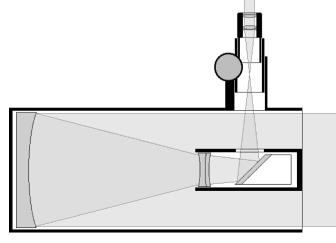Other Types
Catadioptric Newtonian Telescopes
Catadioptric Newtonians are gaining popularity fast. Although such telescopes have been around for some time, new versions are fast coming on the market.
Of these, the short tube Newtonians are the most popular, although Maksutov and Schmidt Newtonian telescopes are also available, of which the latter is possibly more common. The principle of the Maksutov and Schmidt Newtonian telescopes is very similar to the Cassegrain versions. They incorporate either the Maksutov or Schmidt corrector plate placed at the front opening of the telescope. The short tube Newtonian telescope, however, works differently with the field correction taking place after the main mirror. There are two versions on the market, of which the simplest is a straightforward fast Newtonian which has a negative lens fitted in the bottom of the focusser. This is no different to using a Barlow lens, and it is debatable if this solution really provides any great benefits. The better option is if the lens is placed much closer to the main mirror. This is shown in the example below.

The telescope incorporates an auxiliary lens, contained in a tube along with the secondary mirror. Situated at the bottom of the tube, closest to the main mirror, this lens stretches the focal length, reduces aberrations and flattens the field. Newtonians using this technique can be built very compact and it makes them some of the most cost-effective telescopes on the market, as they are only slightly more expensive than ‘normal’ Newtonian telescopes. The only real disadvantage is the fact that they are open and therefore prone to air turbulence and gathering dust.